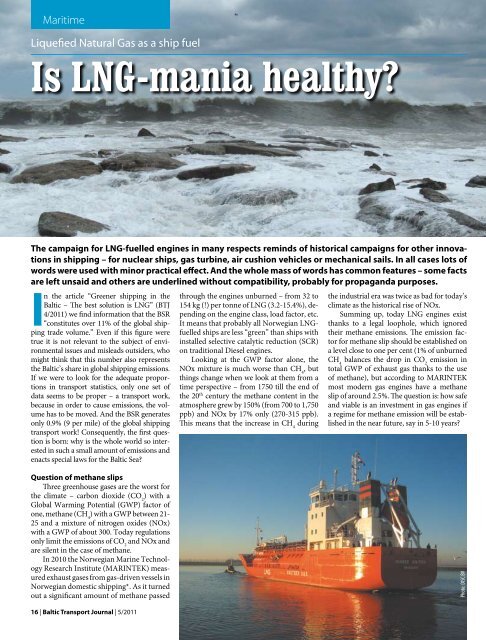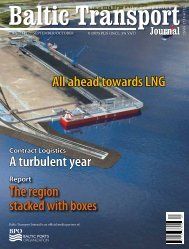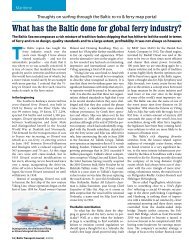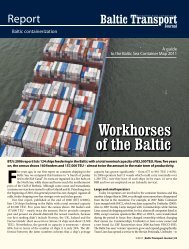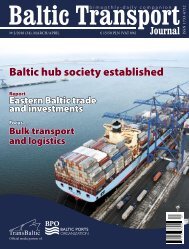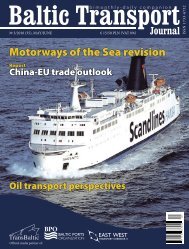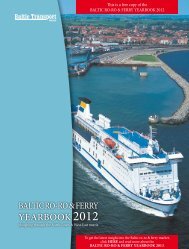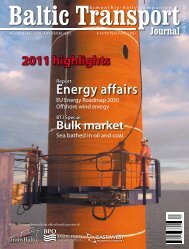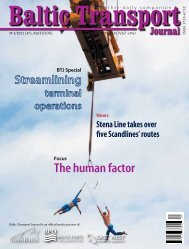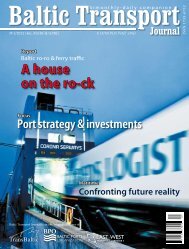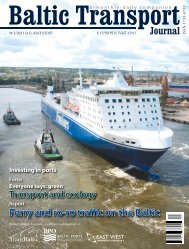MaritimeLiquefied Natural Gas as a ship fuelIs LNG-mania healthy?The campaign for LNG-fuelled engines in many respects reminds of historical campaigns for other innovationsin shipping – for nuclear ships, gas turbine, air cushion vehicles or mechanical sails. In all cases lots ofwords were used with minor practical effect. And the whole mass of words has common features – some factsare left unsaid and others are underlined without compatibility, probably for propaganda purposes.In the article “Greener shipping in the<strong>Baltic</strong> – The best solution is LNG” (<strong>BTJ</strong>4/<strong>2011</strong>) we find information that the BSR“constitutes over 11% of the global shippingtrade volume.” Even if this figure weretrue it is not relevant to the subject of environmentalissues and misleads outsiders, whomight think that this number also representsthe <strong>Baltic</strong>’s share in global shipping emissions.If we were to look for the adequate proportionsin transport statistics, only one set ofdata seems to be proper – a transport work,because in order to cause emissions, the volumehas to be moved. And the BSR generatesonly 0.9% (9 per mile) of the global shippingtransport work! Consequently, the first questionis born: why is the whole world so interestedin such a small amount of emissions andenacts special laws for the <strong>Baltic</strong> Sea?through the engines unburned – from 32 to154 kg (!) per tonne of LNG (3.2-15.4%), dependingon the engine class, load factor, etc.It means that probably all Norwegian LNGfuelledships are less “green” than ships withinstalled selective catalytic reduction (SCR)on traditional Diesel engines.Looking at the GWP factor alone, theNOx mixture is much worse than CH 4, butthings change when we look at them from atime perspective – from 1750 till the end ofthe 20 th century the methane content in theatmosphere grew by 150% (from 700 to 1,750ppb) and NOx by 17% only (270-315 ppb).This means that the increase in CH 4duringthe industrial era was twice as bad for today’sclimate as the historical rise of NOx.Summing up, today LNG engines existthanks to a legal loophole, which ignoredtheir methane emissions. The emission factorfor methane slip should be established ona level close to one per cent (1% of unburnedCH 4balances the drop in CO 2emission intotal GWP of exhaust gas thanks to the useof methane), but according to MARINTEKmost modern gas engines have a methaneslip of around 2.5%. The question is: how safeand viable is an investment in gas engines ifa regime for methane emission will be establishedin the near future, say in 5-10 years?Question of methane slipsThree greenhouse gases are the worst forthe climate – carbon dioxide (CO 2) with aGlobal Warming Potential (GWP) factor ofone, methane (CH 4) with a GWP between 21-25 and a mixture of nitrogen oxides (NOx)with a GWP of about 300. Today regulationsonly limit the emissions of CO 2and NOx andare silent in the case of methane.In 2010 the Norwegian Marine TechnologyResearch Institute (MARINTEK) measuredexhaust gases from gas-driven vessels inNorwegian domestic shipping*. As it turnedout a significant amount of methane passedPhoto: DISC BV16 | <strong>Baltic</strong> Transport Journal | 5/<strong>2011</strong>
Question of competing technologiesLNG has strong competitors – the aforementionedSCR is the most popular in Norway.54 ships equipped with Diesel engineshad such installations at the end of 2010– 35 serving the offshore industry, 17 fishingvessels and three – cargo. Actual measuresshow that SCR diminishes NOx emissionsby 83%. Additionally, 52 ships passed anengine rebuilding procedure called ‘optimization’,which reduces NOx emission by37%. Most interesting is a combination ofthe SCR and ‘optimization’ which was thecase for only four Norwegian vessels. Sadly,MARINTEK didn’t publish data on emissionfrom such a hybrid solution.Twenty Norwegian ships with LNG enginesagainst over 100 with competitive technologiesshow the market’s choice (in all casessupported by the state). Among LNG-drivenships there are only inland ferries, CoastGuard vessels and one PSV – ships with freecapacity in hulls. The number of engine-‘optimized’ships includes two passenger ships, fivecargo, 15 offshore and 24 fishing vessels.The advantage of an improved Diesel enginecould be predicted on a historical andeconomic basis. This engine since its very beginning(the first ocean-going Diesel drivenship, the Danish Selandia, set sail in 1912)was competing with the steam engine, steamand gas turbine and always won thanks toslow but continual improvements. Developmentdoesn’t stop and “green” Diesel will becheaper in total installation and operationcosts than the LNG engine. Another factor isthat fitting LNG tanks into a modern cargovessel with a highly rationalized hull and deckcapacity seems to be a step back towards theera of steam, because the engine space has tobe enlarged at the cost of cargo holds. Let usremind that the removal of boilers and transferof bunker stores to corners of the hull wasthe first and largest rationalization in a mechanically-drivenvessel. Costly pioneeringDiesel engines were self-financed by earningson better utilization of hull capacity. Now thesituation is being reversed as LNG enthusiastscall for taxpayers’ money for improvementswhich will diminish a shipowner’s income.Question of solidarityIn light of MARINTEK’s research the LNGengine has only one real advantage over Diesel– its methane exhaust doesn’t include solidand soluble particles. Of course, they will be lefteven in the best MDO and HFO, which meetfuture MARPOL requirements. But, accordingto MARINTEK’s deep evaluation, particulatesmatter has a complex nature. CleanerMaritimefuels could lose their grade – the report says:“There will probably not be enough low sulphurcrude oil available to meet the demands,and the average quality of heavy fuel oil mightsuffer. This might lead to higher emissions ofparticles, originating from the combustionprocess.” Black carbon particles act in the atmospherelike greenhouse gases – making theworld warmer. But sulphur added to a blackcarbon particle works like a ballast tank – it absorbswater from the air and forces the particleto land quickly. In its conclusion MARINTEKstates: “The effect on the climate when reducingsulphur seems to be mostly negative since theblack carbon lifetime increases due to a longerlife time in the atmosphere.”World shipping utilizes the waste madeby oil refineries, it can’t stop doing this.But the solidarity in this work has beenbroken because of the idea that we canrun away to an LNG heaven from the effectsof marine liquid fuels combustion.MARINTEK has said that such an escapeis impossible. An LNG heaven does not existyet and there is only one atmosphere. Marek Błuś* Jørgen B. Nielsen, Dag Stenersen, Report. Emission factorsfor NH 4, NOx, particulates and black carbon for domesticshipping in Norway, revision 1, MARINTEK, 23.11.2010.A crossroads for markets –A road map for the futureAsk for exhibitorinformation now!www.transfairlog.comFIRST TRADE FAIR FOR INTERNATIONALTRANSPORT AND LOGISTICS MANAGEMENT12 - 14 June 2012Trade Fair Centre Hamburg, GermanyOrganiser:EUROEXPO Messe- und Kongress-GmbHTel.: +49 89 32391-241Fax: +49 89 32391-246E-mail: transfairlog@euroexpo.deInternet: www.transfairlog.com5/<strong>2011</strong> | <strong>Baltic</strong> Transport Journal | 17


